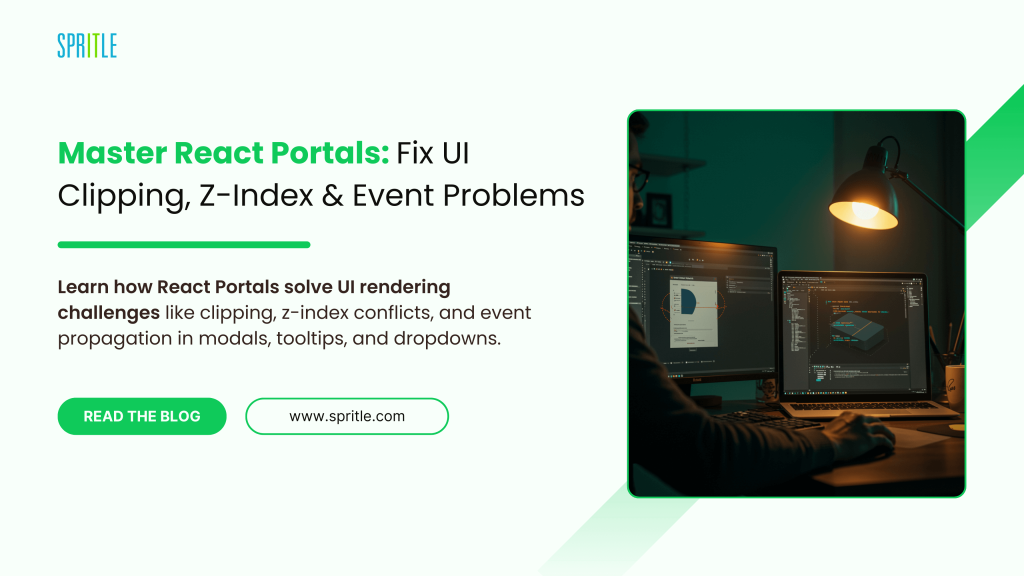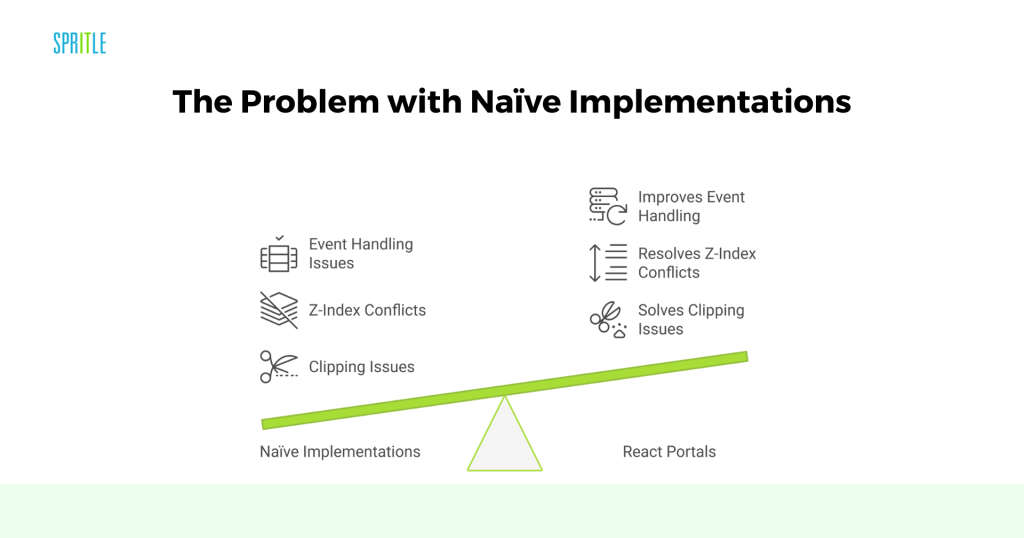Master React Portals: Fix UI Clipping, Z-Index & Event Problems
Fix UI rendering issues using React Portals for clean modals & tooltips The post Master React Portals: Fix UI Clipping, Z-Index & Event Problems appeared first on Spritle software.


Introduction
React Portals provide a way to render elements outside their parent component while maintaining the React component tree structure. This is particularly useful for UI elements like modals, tooltips, and dropdowns that need to escape container restrictions. By using ReactDOM.createPortal, developers can control rendering locations without affecting state or event propagation, ensuring seamless integration with React’s ecosystem.
The Problem with Naive Implementations
When building complex user interfaces, we often encounter scenarios where UI elements like modals, tooltips, dropdowns, or popovers need to be displayed above all other content. A naïve implementation of such elements involves rendering them inside their parent component. However, this approach can introduce several challenges:
- Clipping Issues: If the parent container has overflow: hidden, the modal or tooltip might get cut off.
- Z-Index Conflicts: UI elements deeply nested in the component tree may struggle to properly layer above other elements.
- Event Handling Issues: Event bubbling may cause unintended behavior, like closing a modal when clicking inside it.
- Performance Constraints: Re-rendering large components with deeply nested modals can cause performance overhead.
To solve these issues, React Portals provide a way to render elements outside their parent hierarchy while keeping them within the React component tree.

What is a React Portal?
A React Portal allows a component to be rendered in a different part of the DOM than its parent, without breaking the React tree. This means that the component remains part of the React application but is physically placed elsewhere in the DOM for better UI management.
How React Portals Work
React provides the ReactDOM.createPortal function, which takes two arguments:
- The JSX element that needs to be rendered.
- The DOM node where the element should be mounted.
For example, a modal can be rendered inside a div with an ID of portal-root, separate from the main app:
Architecture of React Portals
React Portals work by leveraging the following architectural principles:
Portals work by leveraging the following architectural principles:
- Virtual DOM Binding: Even though the portal component is rendered outside its parent, it still remains connected to the React tree, meaning state and context are preserved.
- DOM Manipulation Efficiency: Portals avoid unnecessary re-renders of parent components when modal-related state updates occur.
- Event Propagation Control: Events triggered inside a portal follow normal React event bubbling, but they can be stopped with event.stopPropagation() if needed.
Implementing UI Rendering Outside Parent in Vanilla JavaScript
In a vanilla JavaScript application, you can achieve similar behavior using JavaScript’s appendChild and removeChild methods:
This approach works but lacks the benefits of React’s component structure, state management, and event handling.
Implementing React Portals
Step 1: Add a Portal Root in HTML
Ensure your index.html has a separate div to mount portal content:
Step 2: Create a Portal Component
Step 3: Use the Portal Component
Benefits of React Portals
- Avoids Clipping Issues: Ensures UI elements like modals and dropdowns are displayed correctly, even if the parent has overflow: hidden.
- Prevents Z-Index Conflicts: Allows elements to be layered correctly above other UI components.
- Improves Performance: Prevents unnecessary re-renders of parent components.
- Enhances Event Handling: Provides better control over event bubbling and propagation.
- Simplifies UI Management: Helps manage UI elements outside restrictive parent containers
Disadvantages of React Portals
- Increased Complexity: Requires managing a separate mounting point in the DOM.
- Limited Styling Control: Global styles may need adjustments for proper integration.
- Potential Event Issues: Event propagation might need manual handling to prevent unintended side effects.
Conclusion
React Portals are a powerful way to break out of the normal component hierarchy while maintaining the benefits of React’s state and context management. They provide a robust solution for handling UI elements that require flexibility in placement, such as modals, tooltips, and dropdowns. By leveraging ReactDOM.createPortal, we can enhance the user experience while keeping our application structure clean and efficient.
The post Master React Portals: Fix UI Clipping, Z-Index & Event Problems appeared first on Spritle software.













































































































































































![[The AI Show Episode 156]: AI Answers - Data Privacy, AI Roadmaps, Regulated Industries, Selling AI to the C-Suite & Change Management](https://www.marketingaiinstitute.com/hubfs/ep%20156%20cover.png)
![[The AI Show Episode 155]: The New Jobs AI Will Create, Amazon CEO: AI Will Cut Jobs, Your Brain on ChatGPT, Possible OpenAI-Microsoft Breakup & Veo 3 IP Issues](https://www.marketingaiinstitute.com/hubfs/ep%20155%20cover.png)




































































































































































































































































_incamerastock_Alamy.jpg?width=1280&auto=webp&quality=80&disable=upscale#)
_Brain_light_Alamy.jpg?width=1280&auto=webp&quality=80&disable=upscale#)






























































































![Senators reintroduce App Store bill to rein in ‘gatekeeper power in the app economy’ [U]](https://i0.wp.com/9to5mac.com/wp-content/uploads/sites/6/2025/06/app-store-senate.jpg?resize=1200%2C628&quality=82&strip=all&ssl=1)




















































































